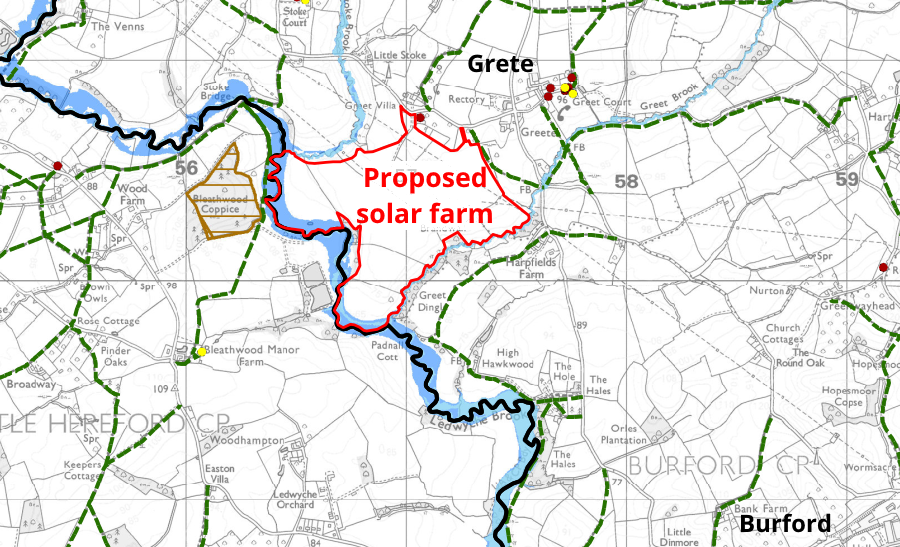Bluefield Renewable Developments is to submit plans for a solar farm near the small village of Greete, which lies between Burford and Caynham. At this stage, it has asked Shropshire Council whether it needs to submit an Environmental Impact Assessment (EIA). Historic England and Shropshire Council’s conservation team have said that an EIA is needed to judge the impact on nearby listed buildings.
One solar farm has already been built off Squirrel Lane. An application for another project on the lane is expected to be submitted shortly. We can expect this trend to continue because of the capacity to connect to the grid at the Squirrel Lane substation.
It will take some months for the Greete application to be processed to a decision. There will be no opportunity for the public or parish councils to comment until a full planning application is submitted.
The proposed Greete site is on 53.23 hectares of agricultural land (132 acres) taking in 11 arable fields with hedgerows and mature trees lining the field boundaries. Bluefield Renewable developments says the site has the capability of generating up to 49.9MW of electricity. Two overhead lines run across the middle of the site. One of these, 132kV voltage, is proposed to be used to connect the solar farm to the grid.
In its submission for a scoping review – the determine whether an EIA is required – Bluefield says the scheme will provide biodiversity enhancements through hedgerow enhancement and wildflower planting on site.
“There is the potential to include further biodiversity enhancements through set-aside, the creation of wildlife corridors and the possible installation of bat and bird nesting boxes, bee hotels, woodpiles, and beehives… In terms of biodiversity at the site itself, the arable fields are bordered by dense, mature vegetation often flanking brooks adjacent to the field boundary edges. The arable fields are considered to be of low habitat value being subject to regular agricultural management. The field boundaries include the presence of mature vegetation, densely wooded areas such as Greet Dingle and established brooks. These offer higher ecological value, and the design of the proposed development will seek to safeguard and retain these features.”
“The location of the proposed solar farm also provides an opportunity to enhance biodiversity and strengthen ecological networks, particularly in relation to field boundaries. Biodiversity can be enhanced through additional on-site planting and potential installation of bat and nesting bird boxes, bee hotels, woodpiles. Fencing used on site will have small mammal gateways fitted to enable free access.”
Bluefield is suggesting that there might be extra planting along the boundaries of the site to ensure it is adequately screened.
The soil at the site is classified as a mix of Grade 2 and Grade 3. The report from Bluefield does not state whether the Grade 2 land is Grade 2A (best and most versatile) or 2B.
All developments, including solar farms, must address flooding issues. While the site itself is not considered to be in risk of flooding, the land and western and southern boundaries of the site are in Flood Zones 2 and 3, those at higher risk of flooding. Bluefield is committing to a Flood Risk Assessment (FRA), including a drainage strategy to mitigate runoff from the panels. This is important as solar panels can increase the flow of water from a previously agricultural field during high rainfall.
The biggest issue at this stage of the application is the impact on nearby heritage assets. The law is very clear. The settings of historic buildings and monuments must be protected as well the structures and landscape. Historic England and Shropshire Council’s conservation team have said the proximity to heritage assets means that a full EIA is required:
“Due to the scale of the proposed development and the proximity to a number of Grade II and Grade II* listed buildings including but not limited to; Greete Court Grade II* and The Church of St James at Greete also Grade II* approximately 450m to the east of the site, Stoke Court Grade II* approximately 600m to the north west of the site and Lower Cottage Grade II immediately adjacent to the north boundary of the site, it is considered that the proposal has the potential to have a substantial impact upon the setting of heritage assets in this instance. Therefore an EIA may be appropriate in this case.”
My view is that an EIA is essential. We need to understand how this scheme will impact on environmental and heritage assets.
If Shropshire Council’s planners rule that an EIA is required, the application will automatically be referred to the Southern Planning Committee.


